In the context of large-scale monetary disputes, the ad-blocking phenomenon has grown into a brutal panic mixed with malevolence and bias, producing an uncomfortable business space for many honest publishers.
With this report, we try to resituate the ad-blocking phenomenon not as a user rebellion against the mothership of the “paid by ads free web”, but as one episode in a much larger cultural quarrel that promises a healthy evolution to improve content quality and accessibility.
As an arms race of blockers versus anti-blockers and versus the limited prospects of anti-anti-blockers promises for all sides, we consider the modernisation of the middle player — anti-blockers (or publisher protection) business so it becomes a hybrid with a tokenized data management platform (DMP). We offer to exchange this wasteful battle for a mutually beneficial, proactive, token-based commerce for consumers, publishers, and DMPs.
Business Context
Problems
Businesses Made Online Content Addictive and Trivial
People had started to disconnect Facebook and Twitter accounts from their personal lives years ago. If you are a Redditor, you might have noticed that the number of upvotes is inversely proportional to the amount of efforts you invest in a post, and exceptions prove the rule. That really raises doubts whether you should read the “hot” page at all. If you are a Quora user — regardless of the scope of your interests — your home page should have surprised you with questions of grotesque stupidity receiving tons of attention and equally stupid answers that get even more attention.
Most people are probably not too disappointed, but many feel the balance has been lost. At some point something went really wrong. Our individualized feeds which have become tat goofy, trivial content should not have become that dominant in the common log-off space. Of course, we’d be naive to expect a truly healthy online environment — the one without the exploitation of people’s psychological vulnerabilities — but it does feel we’ve made the cup run over.
Ad-blocking is Only the Initial Phase of Public Reaction
The line has also been crossed by annoying ads. Thus, we now have ad-blockers at the adoption rate up to ½. If you tried it, there’s no come back from using ad-blocking.
We may soon have “deep-taught” ad-blockers that are impossible to circumvent or tame.
To be fair, online advertisers’ tolerance to using obnoxious ads hasn’t been developing in a vacuum. The current design of the mainstream feedback loops is awry and loops are generally too short. It shouldn’t be so simple to promote or downvote a piece of content. The dominance of trivial content is the result of business models based on addiction-provoking tactics. The culture of “likes” is deeply connected to the cost-per-click model — what if all this was a mediocre idea from the start? The online oligopoly members, headed by Facebook and Google — who enjoy ¾ of all ad revenue — are eager to safeguard their privileges and padlock their ranks. Now, when we see the elite has obviously erred, it is essential for publishers to take a stand and chose the people’s side.
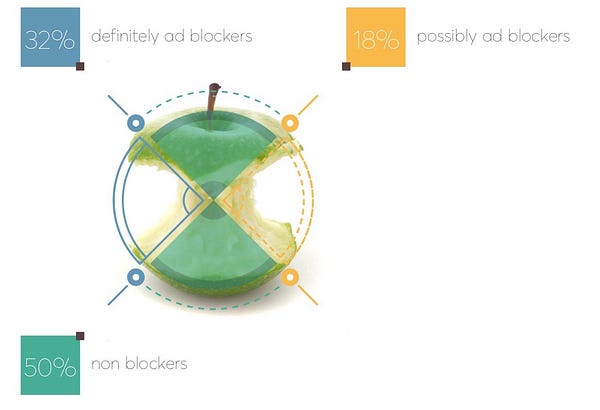
Problem Turned into Opportunity
The two problems above are connected, worsening daily and may be forming the death spiral. Every fatal change develops to the “problem acceptance stage” when the comforting understanding comes: “Challenges are always accompanied by opportunities.” There is a peculiar double negative (converting to positive) that the ad-blocking phenomenon started signaling recently, as stats piled up high enough.
The very fact of using a piece of an ad-blocking software appears to be a universal marker to identify users with advanced attention and IQ metrics.
Ironically, the simplest way to filter out your most profitable website visitors is the technology that breaks usual monetization processes. Ad-blocking users represent a hefty, unmonetized chunk of the market that remains dormant. Ad-blocking is indeed an apt filter that would probably take a large marketing budget if designed and deployed through ordinary behaviour data processing tools. The ad-blocking audience is your gold that is panned for free.
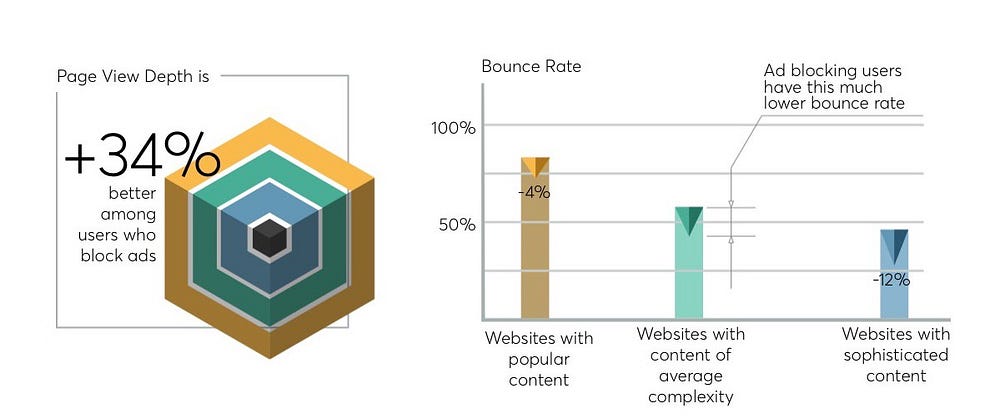
Solution
The frequently pronounced line in the ad-blocking debate is “let’s try to cure things by becoming better, all of us.” The question is: who’s going to pay for that? Truly “native” advertising, forcing certain ethic codes and advertising policies, tilting to whitelisted display networks, giving up some ad revenue in favor of selling some expertise — all those things are not cheap or easy.
It’d be untutored to expect the re-emergence of a healthy advertising environment with Chrome’s built-in ad-blocker — if you can’t beat them, join them. For decades, in older media, the content and advertising have been censored via multiple bodies such as FCC, NARB, NAD, NAB, etc., but it didn’t help too much.
The ad-blocking standoff itself is only a part of the current industry dysfunction. Other crises are peeping over the parapets, ready to join the pivotal moment. Will users — especially when equipped with the new blockchain-based micropayment capabilities — en masse rush to new content-on-demand platforms as it is already happening in other media segments with Netflix, Amazon, and iTunes? Will publishers face the slavery platform trap?
So, what are the options? Selling content is equal to leaving the business and only works for a very few publishers. Reducing the damage by offering direct communication with blocking users and reinforcement of some ads has its limits. From an ordinary publisher’s standpoint, for the sake of momentary business efficiency, it’s not a sin to use a third-party service, even if it broadcasts some inferior ads. And after all, innocent publishers have been turned into cannon fodder in a war they didn’t start. But doing nothing — what most publishers chose to do — poorly suits a true business mind.
We believe counter ad-blocking can be modernized to become a broader publisher protection tool. Although united by the ad-blocking factor, those advanced users are not a uniform stratum. Their demographic and lifestyle diversities remain vast; they still need to be divided to conquer. To pull those viewers back into the equation, every publisher needs to start from scratch and contrive his own approach.
Inventing is hard but nature often gives us tips and suggestions. For example, a good way to plan a city park is to start with all-grass and let people show with their own footprints where the trails should be stone-paved. Similarly, integrating the parallel-to-normal token-based calculus in the user-publisher-DMP loop will create an ongoing experiment which will eventually give us precise answers to who wants what and how much everybody is ready to pay.
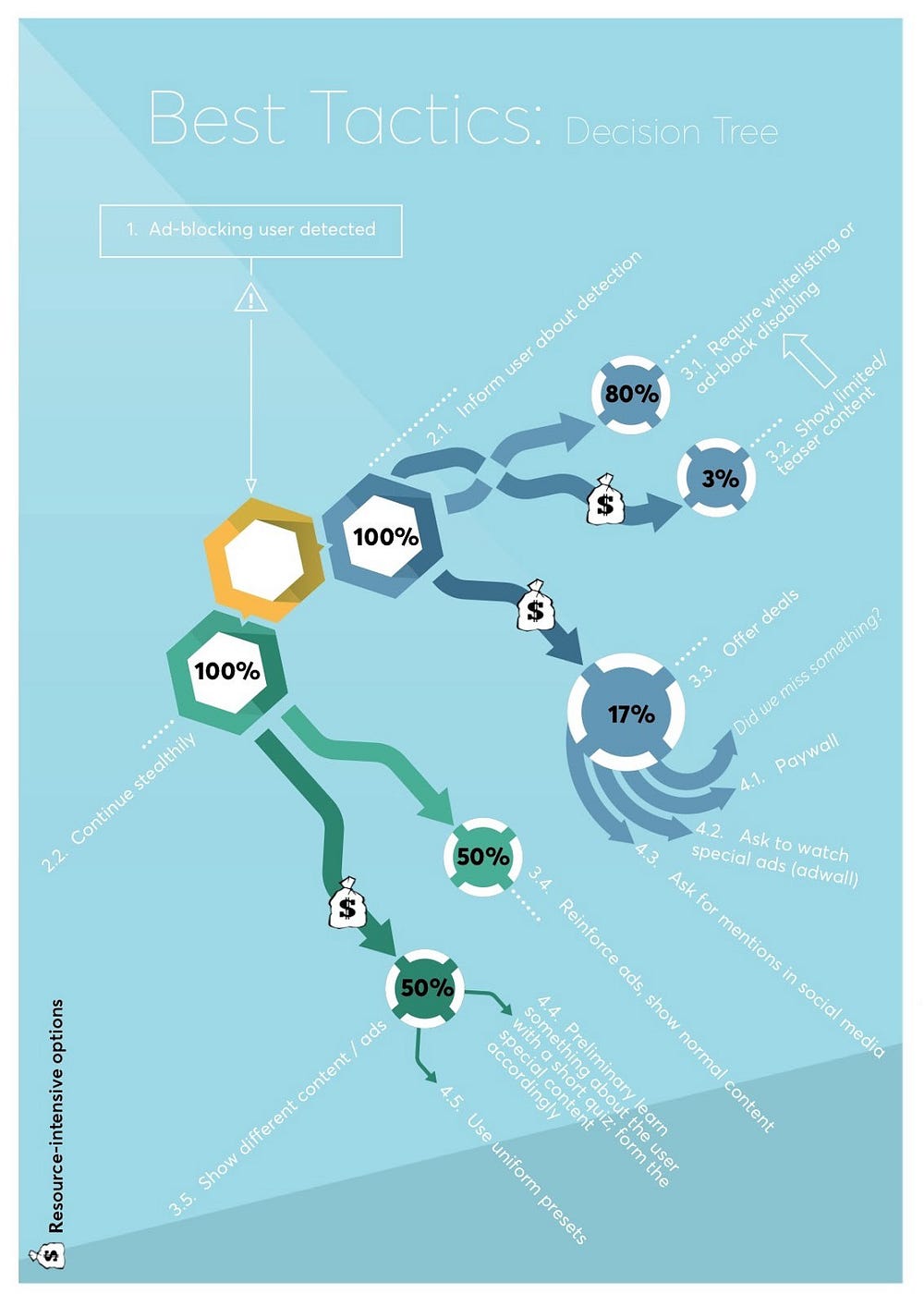
Modernization Through Tokenization
Letting the natural market forces of supply and demand shape the exact design of things is often a rewarding approach. Can a token-enabled marketplace for user personal online behaviour data and content provide a solution for the ad-blocking threat to online advertising industry? Very likely so.
Minimum requirements for the marketplace are smart encapsulation of attention and access quanta, security measures for both data storage and exchange regimes. For any transaction, two parties need a mediator, or at least an observer, possessing the mutually recognized authority or ability to apply direct force. Because of human nature, transactions conducted without such oversight tend to go outside of the planned format. Tokenized marketplace has all these features by default, for almost free!
To participate, consumers will need a browser add-on or the mobile app. That’s the very difficult but doable part. Most probable baits to make consumers install these token-enabling modules are:
- “ad-blocking upgrade” (that’s whom we target the most, anyway) and
- “crypto upgrade” (which should also be appealing for these advanced users who might want to start their crypto journey with collecting free token airdrops that we can aggregate for them from the entire crypto universe).
What differentiates such “competent” users from ordinary ad-blockers is the multi-tiered capability of data blockade and payments. Spying attempts are nipped in the bud. Pixels, cookies, syncing… old are deleted; new are doomed.
There will also be more data: besides ordinary online surveillance records, there is some indexed lifestyle data combined from conscious inputs by the user.
Of course, websites must have compatible modules to communicate and trade with such users, but that is not a problem — the publisher protection service simply includes them into a routine software and terms upgrade. There are four basic options to process the pageview by a token-enabled visitor: no toll and free access, no toll and no access, trade and direct p2p payment, payment done on behalf of third party.
Two-party deals are pretty straightforward. Specific markers (i.e. digital certificates) are needed for both sides to recognize a potentially valuable deal. Tokenized certificates for a consumer are comprised of survey responses and feedback for a given advertisement. Certificates for a content provider are an accumulated user rating. Each agent in the transaction has access to these markers and can initiate or terminate a deal through such transactions. Deals work for both ad impressions and access sales.
In the case of the third-party deals, consumers and webmasters use their connection to a data management platform, which becomes an intermediary for the potential deal. One-time access keys should allow for data-management platforms to broker ad deals. Such “local” DMP manages to give birth to many arrangements that otherwise would never take place, therefore they can charge fees and profit.
If paying on behalf of a third party, webmasters might enjoy some additional income from the brokerage. Advertiser’s instruction may sound like this: “Should you come across a “competent” user, please pay him — not more than this much — and display the ad.” The trade system should allow webmasters to try to automatically bargain a better deal and keep the difference.
In this exchange, a website may offer a default “reward” — free content for a consumer — and also an individual “reward” that is being defined based on the balances of tag tokens owned by both the consumer and website. This individual reward can be literally anything: goods, services, discounts, other privileges.
“In return for” the rewards from a website, the consumer observes ads and allows performing the work on the data that helps the further improvement of targeting for later advertising. The component of mutuality is important. The interfaces for all modules should have the options to conduct a “slow dialogue”: a user may be prompted with short surveys or single questions. This may be based on watched ads, recent browsing history, previous answers, etc.
Digital advertising is ultra-complex, opaque and possibly corrupt; in the end, both advertisers and publishers lose, they say. True, but who should care about publishers and advertisers besides themselves and why? No consolidated business party is present to push for the revolution. The people (users) won’t help either: for the most part, they don’t really care about their personal data being stolen and abused. Openness among industry players is hard to expect — it’s against human nature. There are no examples of truly transparent frameworks on this planet. Besides, there is probably no reason to worry: most real-life systems are over-complex; they lose around half their value in friction and general entropy. A η=50% is normal for self-sufficient systems (think about the car in your garage). After all, revolutions are rare and if one happens, most likely, the consequences are really bad.
The “RTB mess” (real time bidding framework) is the evolutionary norm. There’s no need to “disrupt” it. As far as non ad-blockers are concerned, the tokenization should play a complementary role and not harm the existing business processes.
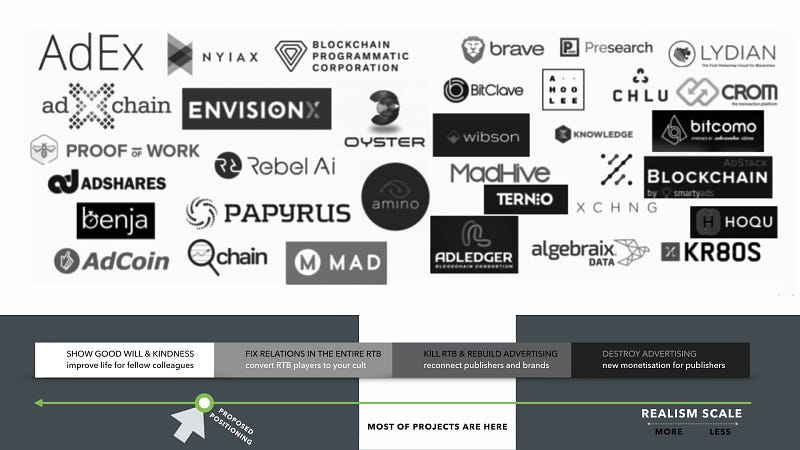
The most successful way to justify a questionable deal is to exaggerate the positive outcome to the buyer. That’s what advertisers do for a living; that’s what the advertising industry claims it does through the practice of targeting. They say it makes advertisements more interesting and more useful. There is only partial scientific support for this claim.
The statistically proven fact reads in a more narrow sense: fewer ads and more targeted ads are better than more ads with less targeting. So, one of the advantages of targeting has to be some reducing of ad pressure. It is not so in the incumbent advertising world. It is so, however, in the proposed token-enabled world.
Paradoxically, the more informative ads are, the less intrusive they appear. Of course, in reality, the amount of data required to make ads more informative and well-targeted is larger to the amount of data needed for a less informative and generally more emotional ad.
To improve targeting capabilities, we propose to create streams of non fungible tagging and benchmarking tokens.
These tokens will be sent to users’ wallets (or browser built-ins) in return to normal online actions (page viewing, shopping) and the new, token-involving activities. Thus, we will involve users in the data collection process. This crowdsourcing of data will go much further than usually proposed marking ads as relevant or not.
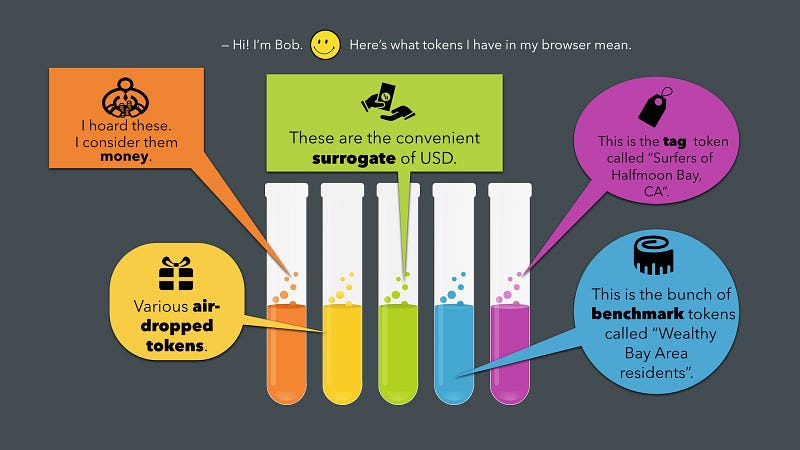
To build a marketplace of any kind, it takes value-packaging standards, currency, currency exchange, and a “safe place” to communicate and trade. Below are the four principal agents who form the basis of online advertising; they will be united by the frictionless payment and token exchange system delivered to actors with browser add-ons and a mobile app connected to the public token platform through the API. The payment system allows for programmatic bids and asks of any goods or services represented by a system-compatible token.
- Consumers who surf the web based on their own intentions.
- Webmaster or website content owners who want to sell products and services.
- Advertisers who seek placement opportunities and payments for placed ads.
- Additionally, the industry includes several types of intermediaries: ad networks, ad exchanges, data management platforms, and others. The latter (DMPs) represent the most relevant agent for our consideration.
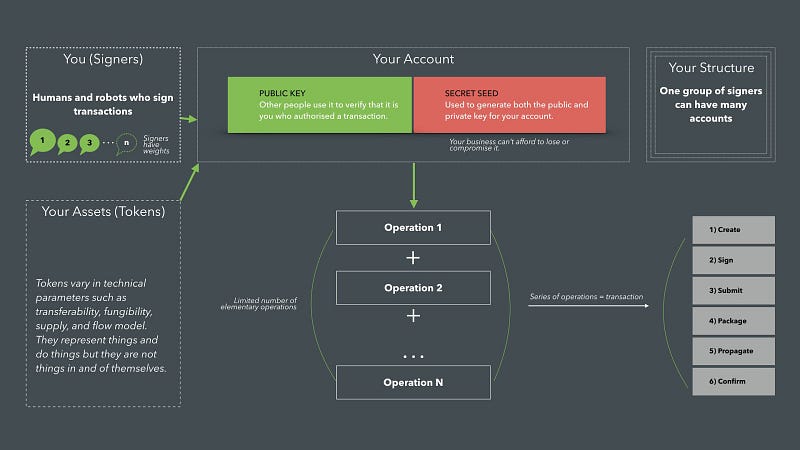
Bridging the Gap Between Consumers and RTB Infrastructure
Data management platforms (DMPs) mine online user metrics via cookie IDs or pixel tags obtained from a user’s web browser. Of course, tagging tokens cannot replace cookies in the bidding process, but there are some aspects where they win. For example, tokens are eternal, while cookies are temporary. Tokens are cross-device and cross-platform because users care about their wallets and not so much the particular tokens those wallets may host. Our marking tokens will just travel along with other valuable stuff.
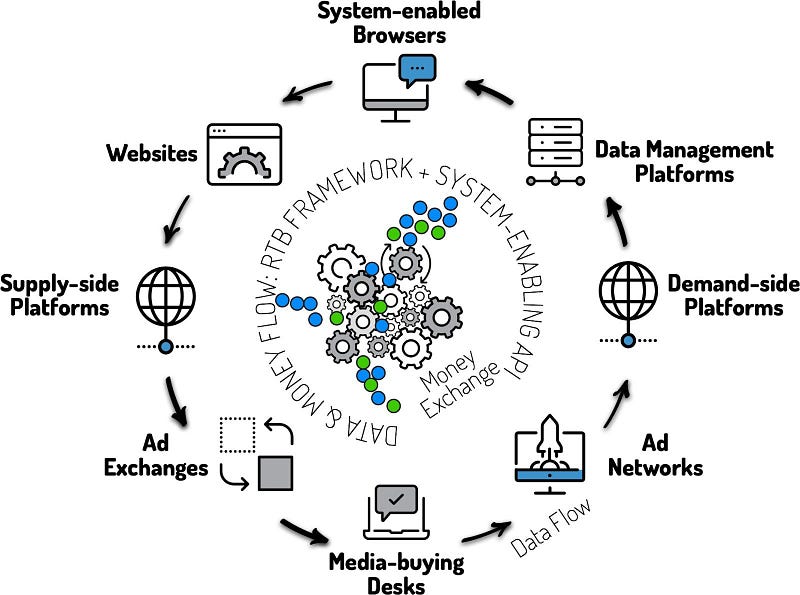
Supply-side platforms were historically set to managing many types of ad inventory levels, so adding token specifics is nothing revolutionary for these organizations. Take one of the largest SSP in the USA, for example: PubMatic’s’ Ad Price Prediction service accepts bids even from non-RTB enabled demand sources such as ad exchanges, ad networks, and direct-to-agency orders. Any bid wins only if it has the highest effective demand-side price.
Two price standards can co-exist. One price is a usual one that depends on user/publisher qualities and the other price takes into consideration that part of the payment has to be forwarded to the consumer.
Within the RTB framework, supply-side platforms have been developing primarily as algorithm-driven systems used by online ad sellers to monetize unsold ad inventory. Sellers used to employ SSPs mostly to increase the value of indirect ad inventory through yield optimization techniques. What might be especially remarkable about tokens is that compatible SSPs will provide sellers with opportunities not only to pinpoint and bundle specific segments of audiences but sell individual ad impressions at premium rates to premium consumers. Typically that can be achieved only by direct ad sales (in-house ad sales division working with ad agency).
DMPs are normally expected to adhere to self-regulatory practices established for online data collection and supply consumer privacy controls in order to maintain trust with agencies and consumers alike. All of the major DMPs offer opt-out tools for users. In contrast, token-based user-data is always protected and can only be released via micropayment (in some case, with a certified promise of the payment). Instead of a primitive opt-out switch, we offer users a complete UI to control the data flow. Thus, consumers may move themselves up in the user-level stats indicated by the compatible SSP tool. SSP operators will clearly see the accumulated effect of token-enabled consumers in terms of revenue acquired by an SSP.
Can we expect some principally new data to emerge as the result of this experiment? Most probably, yes, and here’s why.
Throughout his daily Internet use, a casual consumer has no particular monetary motivation. Basic indifference to advertising is the norm. Some ads are worth watching and others are not. By contrast, a typical webmaster has strong vested interests. There’s either an attempt to sell the visitor’s attention to another advertiser at a higher price or a bid to justify a higher price to the same advertiser for showing their ad to users. Thus, webmaster’s inner eye focuses on consumer’s private data which eventually tilts commercial interests from venal to corrupt. Note the imbalance of the trade! Now, the two parties interact and exchange values in both directions, but the commercial vector seems quite strong. Once we add a seamless way to place bids and ask for virtually any values involved in the process, some “streams of fairness” may naturally occur. We don’t expect that any considerable fraction of users will care at all, but it doesn’t take a critical mass to form a noticeable pattern. Through the active minority, we will surely see some new truth.
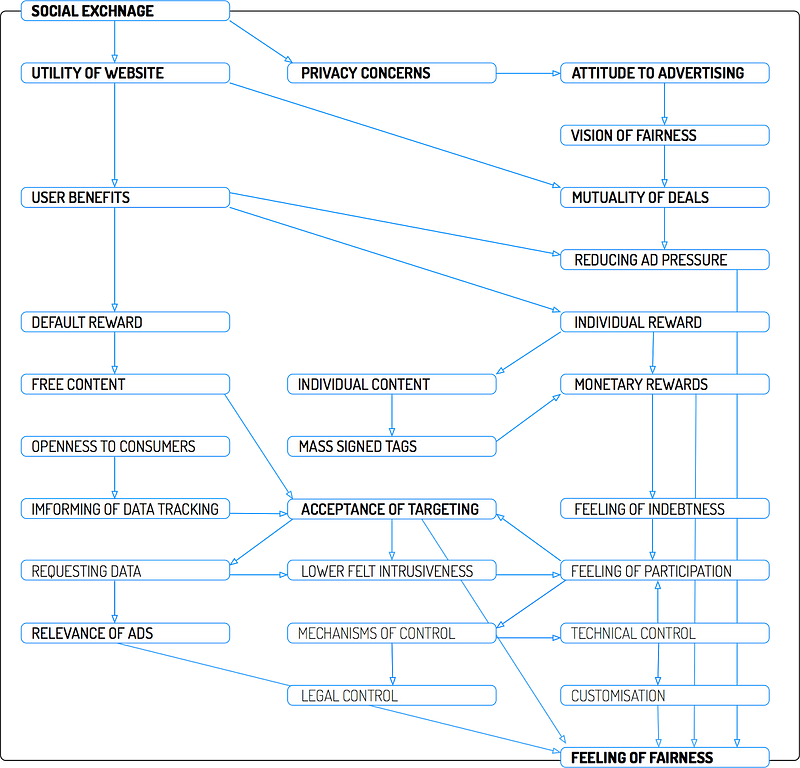
Forming the feeling of fairness in advertising may be very complex. It is not clear if consumers would be willing to accept targeting clarification prompts, even if they feel they receive at least as much as they give. This feeling is very hard to “quantify”. To make consumers feel comfortable, and therefore willing to cooperate, we not only need to fully inform them of the ad-targeting practices, but also make them able to customise every parameter involved.
SOURCE: https://medium.com/token-suisse/tokenization-use-case-publisher-protection-21c47f76cefe
Write By
Applied Token Economics http://ate.business